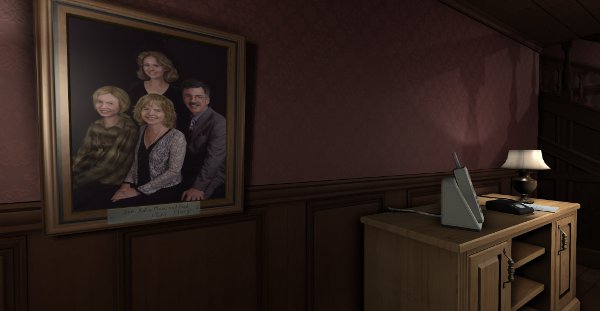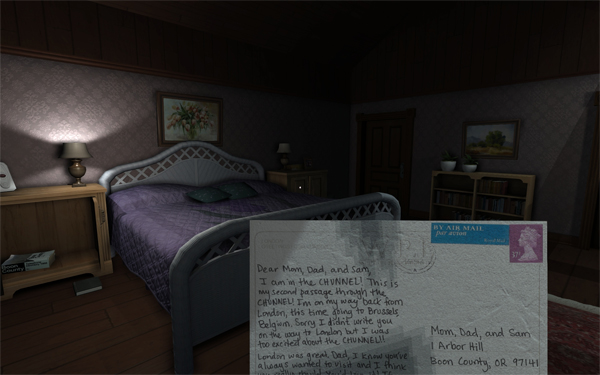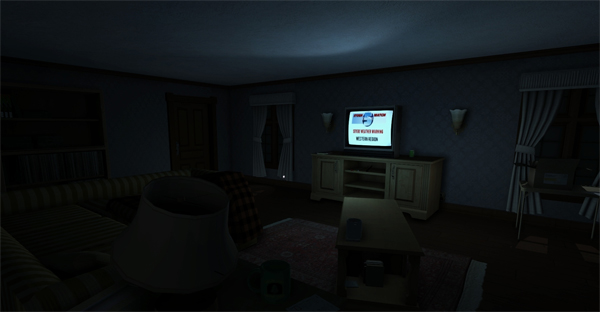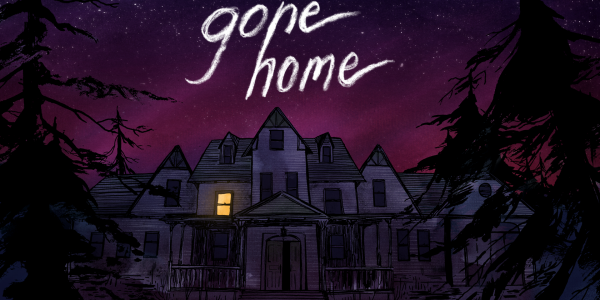In Gone Home, you play as Kaitlin “Katie” Greenbriar. The game starts when Katie arrives on the front porch of her family’s home in Oregon. Katie is ready to relax after returning from a yearlong trip to Europe. Circumstances dash these plans once Katie discovers that neither her parents nor her younger sister, Sam, are at home. Sam left a mysterious note on the front door, telling Katie she is gone and doesn’t want anyone to find her. “We’ll see each other again some day,” reads Sam’s note.
 So begins the story of Gone Home. As Katie, you explore your family’s eerie house in order to unlock the mystery of Sam’s disappearance. The setting is new to Katie because her family moved into this home during her absence. Thus both Katie and you are familiarizing yourselves with the residence. Along the way you uncover bits of information about the Greenbriar family through letters and photographs. These items are often accompanied by voiceovers from Sam (adroitly performed by actress Sarah Grayson) as she reads from her journal entries.
So begins the story of Gone Home. As Katie, you explore your family’s eerie house in order to unlock the mystery of Sam’s disappearance. The setting is new to Katie because her family moved into this home during her absence. Thus both Katie and you are familiarizing yourselves with the residence. Along the way you uncover bits of information about the Greenbriar family through letters and photographs. These items are often accompanied by voiceovers from Sam (adroitly performed by actress Sarah Grayson) as she reads from her journal entries.
Gone Home controls like a first-person shooter. The game, however, plays closer to first-person adventures like Myst. In fact, Gone Home reminds me of the 1996 game Amber: Journeys Beyond, which holds a cult status among adventure video game aficionados. Your interactions with the world involve simple tasks such as opening doors, turning on lights, and picking up objects to inspect. Unlike Myst and its brethren the emphasis in Gone Home is not on puzzle-solving. The few “puzzles” you will encounter typically involve discovering the correct combination for a lock. With the exception of a few locked doors Gone Home is non-linear and allows you to explore the Greenbriar house in any order you wish.
The letters and other documents you find make little sense by themselves. Over time, however, these pieces of information build an emotional storyline full of well-rounded, sympathetic characters. In fact, the characterization here rivals that of many better known, story-driven video games. I don’t want to delve any further into the story for fear of spoilers. Suffice it to say that you may find yourself tearing up at the tale’s conclusion. Not that I did, of course. No way!
 The house is as much a character as the Greenbriar family. The residence is a large, old, dimly-lit mansion that holds multiple secret panels and passages. This, combined with the thunderstorm outside, creates a haunting atmosphere that plays with your perception. I felt myself easing into dark rooms with trepidation, reluctantly flipping the light switch in fear of what the illumination might reveal. On more than one occasion I jumped when I thought I saw something in the distance or in my peripheral vision. These were all creations of my mind, influenced by the excellent atmosphere that indie developer Fullbright Company created.
The house is as much a character as the Greenbriar family. The residence is a large, old, dimly-lit mansion that holds multiple secret panels and passages. This, combined with the thunderstorm outside, creates a haunting atmosphere that plays with your perception. I felt myself easing into dark rooms with trepidation, reluctantly flipping the light switch in fear of what the illumination might reveal. On more than one occasion I jumped when I thought I saw something in the distance or in my peripheral vision. These were all creations of my mind, influenced by the excellent atmosphere that indie developer Fullbright Company created.
Indeed, a major theme of the game is how it plays with your expectations. This extends to both the story and overall tone. As a horror game fan, I began playing Gone Home with certain preconceived notions. I am used to playing dread-filled, adrenaline pumping horror games like Amnesia: The Dark Descent. Given its premise and setting, I expected the same from Gone Home. What I received instead is a slower-paced, atmospherically-driven game that cannot be easily placed into any one genre. It is refreshing to be surprised by a video game, especially in an era when so many stoop to cliches.
Gone Home is not going to win any awards for its visuals. The graphics nevertheless adequately serve the story and setting. I particularly enjoyed the game’s art design. Gone Home takes place on the night of June 6, 1995. As a result, it is filled with mid-1990s aesthetic. Katie comes across magazines mourning Kurt Cobain’s death and VHS tapes labelled with movies from that era. Thankfully none of these 1990s relics feel intrusive and are rather an organic part of the environment.
 The sound design is excellent. You hear each creak of the house as you walk through it. This, combined with the pervasive sounds of rain and thunder, create an immersive experience. The music is subdued, but adequately conveys the story’s emotional resonance. You can find and play Sam’s punk rock cassette tapes that are scattered around the house. I can’t speak to the quality of the music itself (not my taste in tunes), but again it further fleshes out Sam as a character.
The sound design is excellent. You hear each creak of the house as you walk through it. This, combined with the pervasive sounds of rain and thunder, create an immersive experience. The music is subdued, but adequately conveys the story’s emotional resonance. You can find and play Sam’s punk rock cassette tapes that are scattered around the house. I can’t speak to the quality of the music itself (not my taste in tunes), but again it further fleshes out Sam as a character.
Gone Home is an excellent, engrossing experience. By the time you are finished you will feel like you know the Greenbriar family as well as your own. The game drives you forward not by zombies to kill or a high score, but purely to uncover the next piece of the story. This, combined with the excellent atmosphere, create an unforgettable experience that will likely set a model for video game narratives to come. My only complaint — and I’m nitpicking here — is that Gone Home has limited replay value. You will complete the game is about two hours your first time through. Subsequent playthroughs will be relatively brisk, less compelling affairs since you already know the story. Nevertheless, this shouldn’t stop your from downloading this excellent game.


















